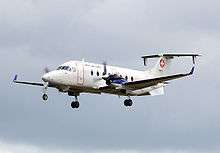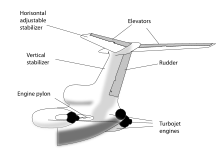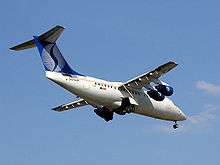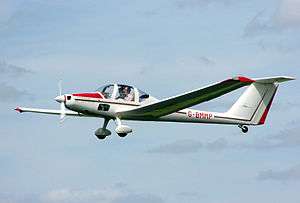T-tail




A T-tail is an empennage configuration in which the tailplane is mounted to the top of the fin. The arrangement looks like the capital letter T, hence the name. The T-tail differs from the standard configuration in which the tailplane is mounted to the fuselage at the base of the fin.
Advantages
The tailplane is kept well out of the disturbed airflow behind the wing and fuselage, giving smoother and faster airflow over the elevators. This configuration may give more predictable design characteristics and better pitch control; but in the case of an aircraft with a tractor propeller, pitch control is reduced because the T-tail takes the control surfaces outside the propeller slipstream. Responsive pitch control is crucial for aircraft flying at low speed, to allow effective rotation on landing. deHavilland Canada's larger STOL aircraft all use a T-tail for this reason. This configuration also allows high performance aerodynamics and an excellent glide ratio as the empennage is less affected by wing and fuselage slipstream. A T-tail has a better effective aspect ratio (better lift slope), less interaction drag than a cruciform tail, and a more efficient vertical tail, the horizontal tail plate effectively increasing the aspect ratio of the fin by virtue of the 'end plate' effect[1] Therefore, the T-tail configuration is especially popular on gliders.
A T tailed airplane is easier to recover from spin than planes with other types of empennage, as the elevator is located above the rudder, thus creating no "dead air zone" above the elevator where the rudder might be ineffective[2]
Where jet engines are mounted on the aft fuselage, as with the Vickers VC10 and the BAC 1-11, a T-tail is essential to keep the tailplane away from the hot exhaust gases.
Disadvantages
The aircraft may be prone to suffering a dangerous deep stall condition, where a stalled wing at high angles of attack may blank the airflow over the tailplane and elevators, thereby leading to loss of pitch control.[3] The F-101 Voodoo suffered from this throughout its service life.
The vertical stabilizer must be made considerably stronger and stiffer (and therefore heavier) to support the forces generated by the tailplane.
The T-tail configuration can cause severe maintenance concerns. The control runs to the elevators are more complex, and elevator surfaces are much more difficult to casually inspect from the ground. The loss of Alaska Airlines Flight 261 was directly attributed to lax maintenance due to the complexity of the T-tail.
Because of concerns about being able to clear the tail, the first high-speed aircraft with a T-tail, the Lockheed F-104 Starfighter, was originally fitted with a downward-firing ejection seat. This prevented pilots from escaping at low altitudes, causing several deaths. For later models of this aircraft, the ejection seat was improved and changed to fire upwards in order to overcome problems in low-altitude escapes.
Due to a lack of airflow over the elevator from a forward mounted engine (piston or turboprop), low speed control is reduced and low speed operation is more difficult for aircraft not designed for low speed operation.
In order to mitigate some of these drawbacks, a compromise is also possible. The tailplane can be mounted part way up the fin rather than right at the top, known as a cruciform tail. The Sud Aviation Caravelle is an example of an aircraft with this configuration.
See also
References
- ↑ Hoerner and Borst, Fluid Dynamic Lift, Directional Characteristics, T-tail page 13-11
- ↑ https://ntrs.nasa.gov/archive/nasa/casi.ntrs.nasa.gov/19720005341.pdf
- ↑ "Gloster Javelin - History". Thunder & Lightnings.

